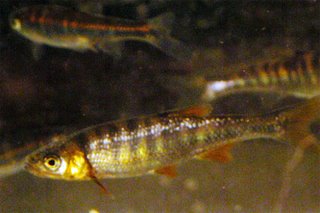Lining Up Students For Research Projects
Now that school has started, I'm running around like a crazy person to teach my two Biology 1 lectures and Vertebrate Reproduction. The Vert Repro class will largely use fish as examples of vertebrate reproduction, so that should be fun. I now have 34 students in the class, by far a record. They seem to be sharp; tomorrow we discuss our first journal article-based example, a classic paper by vom Saal et al. from Science in 1983 on the effects of embryonic exposure to estradiol in mouse pups. Basically, those male pups with higher exposure seem to be more sexually active and less aggressive; "I'm a lover, not a fighter"?
As well as terrorizing undergraduates with serious endocrinology, I have students starting and picking up various projects. Leigh has agreed to do a project to characterize certain neurons in the scarlet shiner brain. I realize that I've started to make the scarlet shiner a model study animal but the species could be good for that. If Leigh is good at dissecting out intact shiner brains, this could be good. The carotenoid pigment extraction project I was thinking of we'll probably do next spring on a representative sample of scarlet shiners. It should tie in with both Leigh's project and also Jennifer's project to characterize testosterone levels in scarlet shiners, and relate that to digital analysis of body color. It's all a lot of work but I'm excited because it's a true integrative biology project, looking at an organism on a bunch of different levels to understand how it makes its living.
I've also accepted an invitation to do a talk on my flame chubs project to an Honors science class offered by the Physics department on campus. The teacher wants a range of scientists at UAH to talk to the class about their research, as an example of how the scientific enterprise works. It's a good excuse for me to pull together all of my data, thoughts and pictures to explain why this project is interesting, and what I've found. I think it's Sept. 25 that I agreed to do this.




